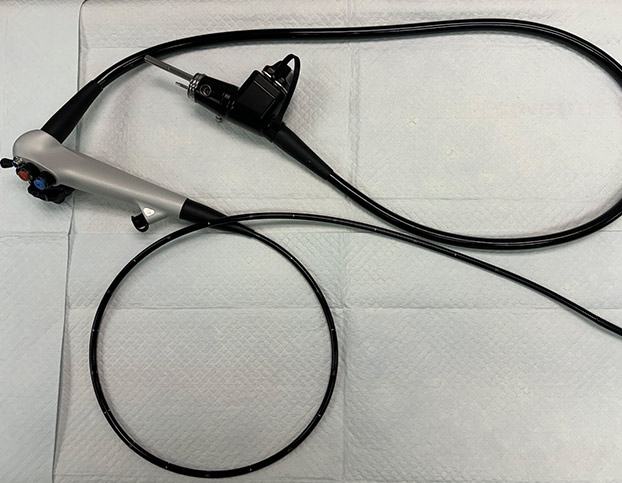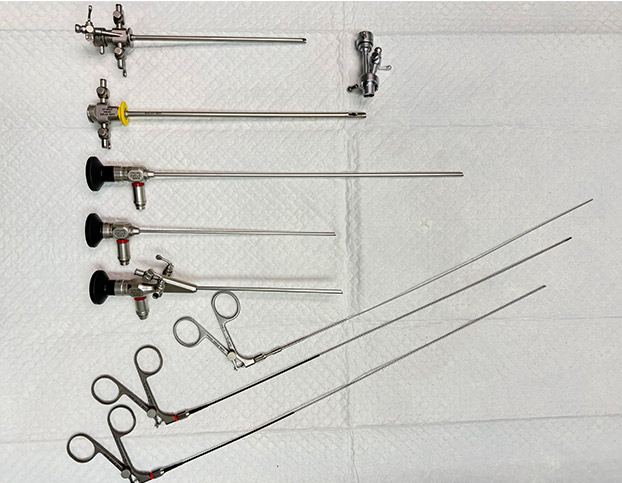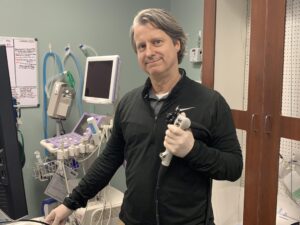What is Endoscopy?
Endoscopy is a non-invasive diagnostic and therapeutic procedure that has revolutionized the field of veterinary internal medicine. Endoscopy is a painless procedure that allows internal areas of your pet’s body to be examined without the need for surgery, incisions (cutting), or prolonged recovery. An endoscope, which is a light-emitting rigid or flexible “tube” (instrument) with a small camera on the end, is inserted into the body to produce realtime video and pictures that are displayed on a high-definition monitor and that can also be recorded.



What Forms of Endoscopy are Available?
Many different areas and organs of the body can be viewed with endoscopy. Depending on your pet’s symptoms, available endoscopic procedures include:
- Gastroscopy: Examines the esophagus and the stomach
- Upper Gastrointestinal Endoscopy: Examines the esophagus, stomach and upper part of the small intestine
- Colonoscopy: Examines the large intestine (colon)
- Bronchoscopy: Examines the airways (trachea, bronchi, bronchioles)
- Rhinoscopy: Examines the back of the nose (nasopharynx) and the nasal passages (see Rhinoscopy article)
- Vaginoscopy: Examines the vagina
- Cystoscopy: Examines the urethra and the urinary bladder
- Capsule endoscopy: Involves swallowing a small pill-shaped capsule that contains a miniature camera that captures images as it passes through the digestive tract
Can Endoscopy Do Anything Besides “Look”?
In addition to viewing the internal structures of body parts and organ systems, endoscopy can perform sampling (biopsies), facilitate the placement of feeding tubes, allow for treatment of esophageal strictures and removal of foreign objects that may have been swallowed or inhaled. Keep in mind that, unlike surgery where incisions would be required, with endoscopy, tissue can be biopsied and objects dislodged and removed all through the scope — no pain, scarring or prolonged recovery.
How is Endoscopy performed?
Endoscopic procedures require general anesthesia, not due to discomfort, but to ensure patient cooperation. Because the health and safety of your pet is of the utmost importance, prior to endoscopy several steps are first needed:
- Routine Blood and Urine Tests: To be sure that your pet is overall healthy
- Specialized Blood Testing: Depending on the symptoms, certain hormone, pancreatitis and intestinal-related blood tests may be important
- Imaging Studies: X-rays and ultrasound are useful to identify other abnormalities (swellings, tumors, growths, etc) that endoscopy would not identify
- EKG: If your pet’s physical exam reveals a heart murmur or heart arrhythmia
Once your pet’s total health is evaluated and understood, your pet is placed under general anesthesia. During anesthesia, a dedicated RVT provides IV fluids to your pet and continuously monitors their vitals: blood pressure, heart rate, breathing rate, blood oxygenation, body temperature.
Only our veterinarians, who are trained and have many years of experience, perform endoscopic procedures. The veterinarian is assisted by a second RVT. During the procedure, one of a variety of endoscopes (based on the body area being examined) is carefully inserted and the internal structures of organs examined.
To allow for easy maneuvering of the endoscope and to allow complete visualization of the organ, air (or sterile saline solution, depending on the area of the body being evaluated) is insufflated (instilled) through the scope (this air or saline is suctioned and removed at the conclusion of the procedure). During the procedure, biopsies are obtained of any tissue that is abnormal in shape, swelling or coloration, and in addition, any retained foreign material is removed.
Depending on the type of endoscopy being performed, the procedure typically lasts between 20 and 60 minutes.
What Are the Risks with Endoscopy?
Like any medical procedure or test, risks do exist. However, for endoscopy, these risks tend to be infrequent. Many potential risks are avoided with a thorough pre-endoscopic examination and routine blood testing and imaging. Since endoscopy requires anesthesia, typical risks (which are rare) could include changes in heart rhythm, breathing abnormalities and body temperature regulation issues. A rare complication that can occur with any endoscopic procedure is perforation (causing a hole) in the body part being examined. The likelihood of this is very minimal when endoscopy is performed by experienced veterinarians.
Many potential risks are avoided with a thorough pre-endoscopic examination and routine blood testing and imaging.
What Cannot be Accomplished with Endoscopy?
Endoscopy can only visualize the organ that is being inspected. For example, when evaluating the intestinal tract, only the inside of the intestinal tract can be seen: abdominal organs and anything “outside” of the intestinal tract cannot be viewed. This is the primary reason that other testing (e.g. imaging) is important to perform before endoscopy. In addition, any masses or tumors that are identified during endoscopy can be sampled (biopsied), however, the complete removal of these masses/tumors is usually not possible as would be during an “open” surgery.
When to Use Endoscopy?
There are many internal medicine diseases and related symptoms where endoscopy can be useful:
- Nasal: Congestion, discharge (drainage), bloody nose
- Gastrointestinal: Drooling, vomiting, regurgitation, weight loss, diarrhea, not eating
- Urinary: Straining or painful urination, blood in the urine, urinary incontinence (leaking)
- Breathing: Coughing, wheezing, producing phlegm
- Colon and Anorectal: Straining to defecate, bloody feces or bloody discharge
- Choking: Inhalation of food or non-food item (toy, kibble)
- Esophageal Foreign Object: Non-food or non-digestible food item lodged in esophagus
After the procedure your pet may be tired, groggy or sedated for several hours — this is normal.
What to Expect After Endoscopy
Endoscopy is an outpatient procedure, and your pet will go home the same day. After the procedure your pet may be tired, groggy or sedated for several hours — this is normal. If a rhinoscopy was performed, there may be a minor intermittent bloody nose for a few hours — this is nothing to worry about. If endoscopy of the digestive tract was performed, it is recommended that your pet be restricted from vigorous exercise for 12 hours while the infused air is allowed to be naturally expelled. If any biopsies were obtained during the endoscopy, these are sent to a veterinary pathology lab with results typically available in 5-7 days.
We Prefer Endoscopy Over Surgery
In conclusion, endoscopy is our preferred option over surgery for sampling (biopsy) or for removing foreign objects. If you have questions about veterinary endoscopy, or wonder if your pet may benefit from this procedure, contact us. As southeast Georgia’s most experienced veterinary internal medicine hospital we have the answers to all of your pet endoscopy-related questions.

Author:
James Woods DVM, MS, DACVIM (SAIM)
Ph: (912) 721-6410
Contact Us
